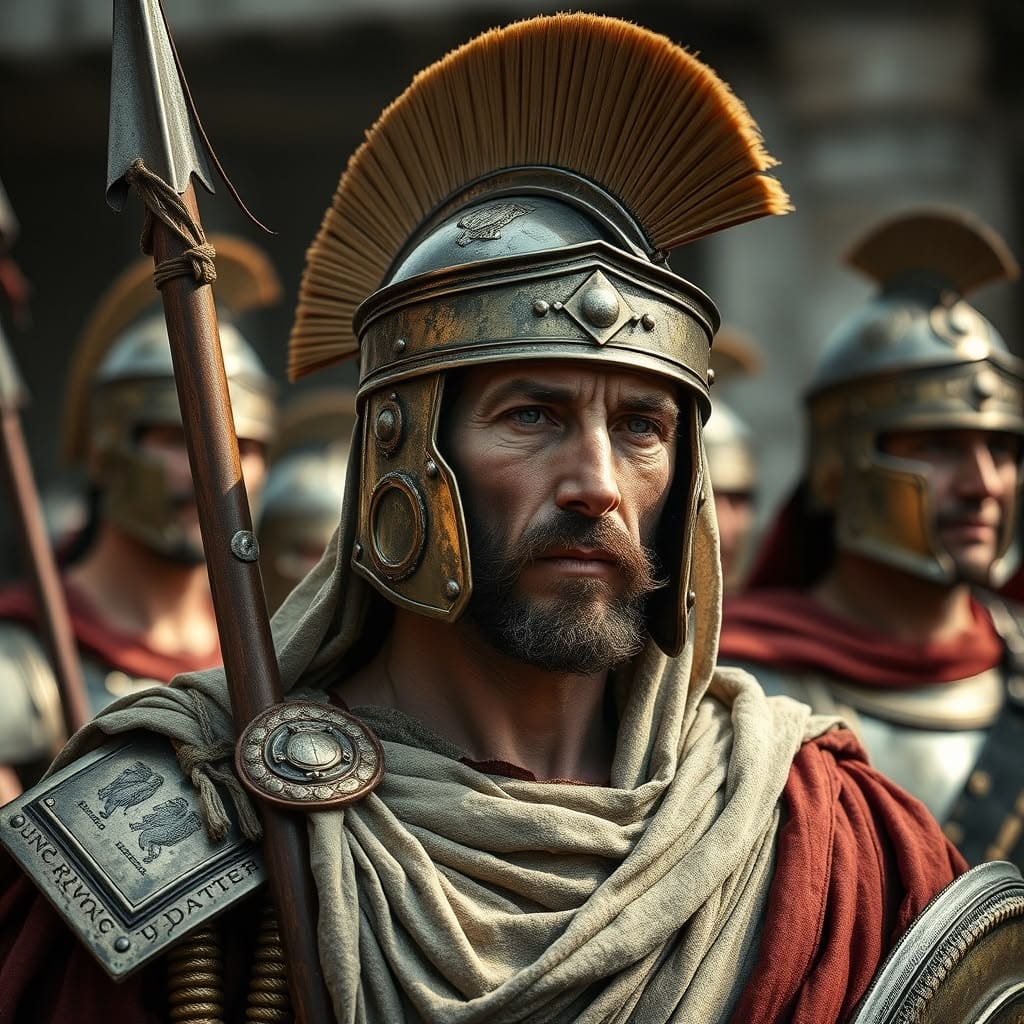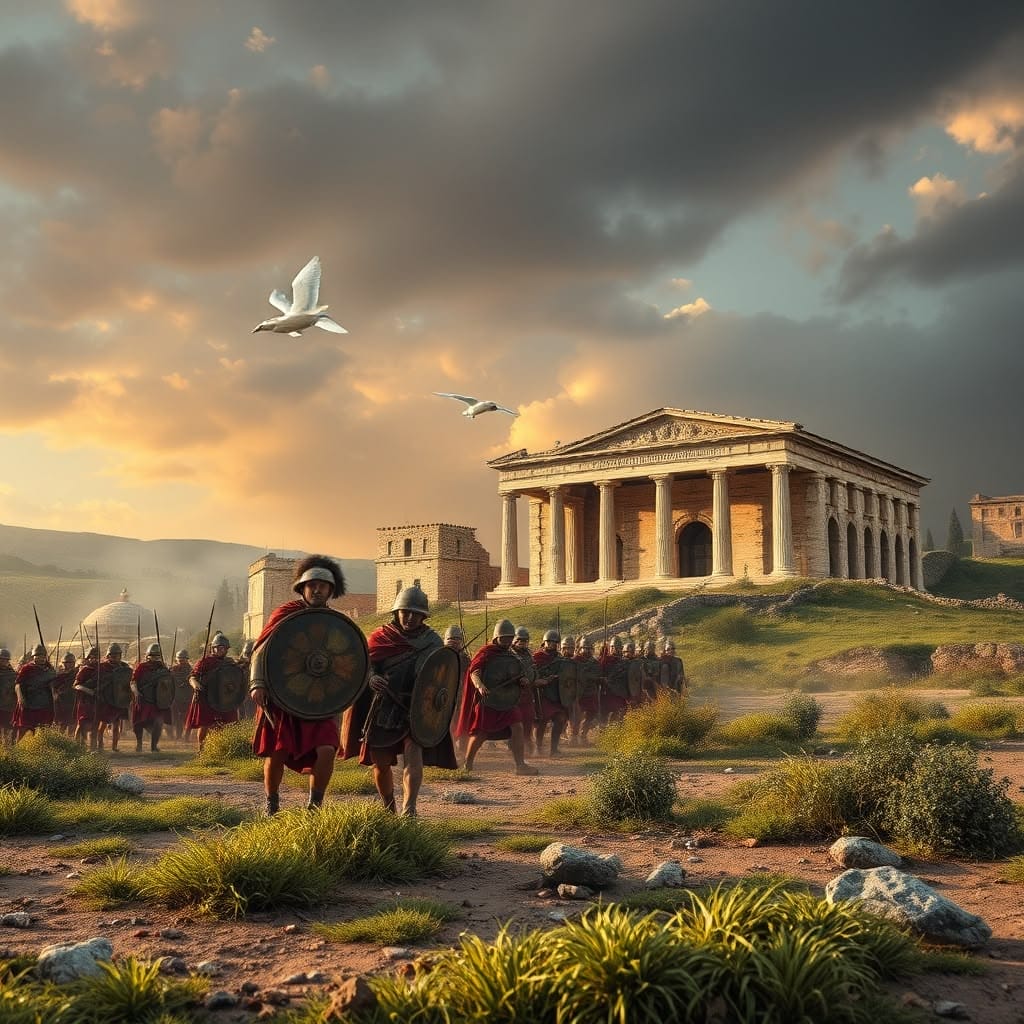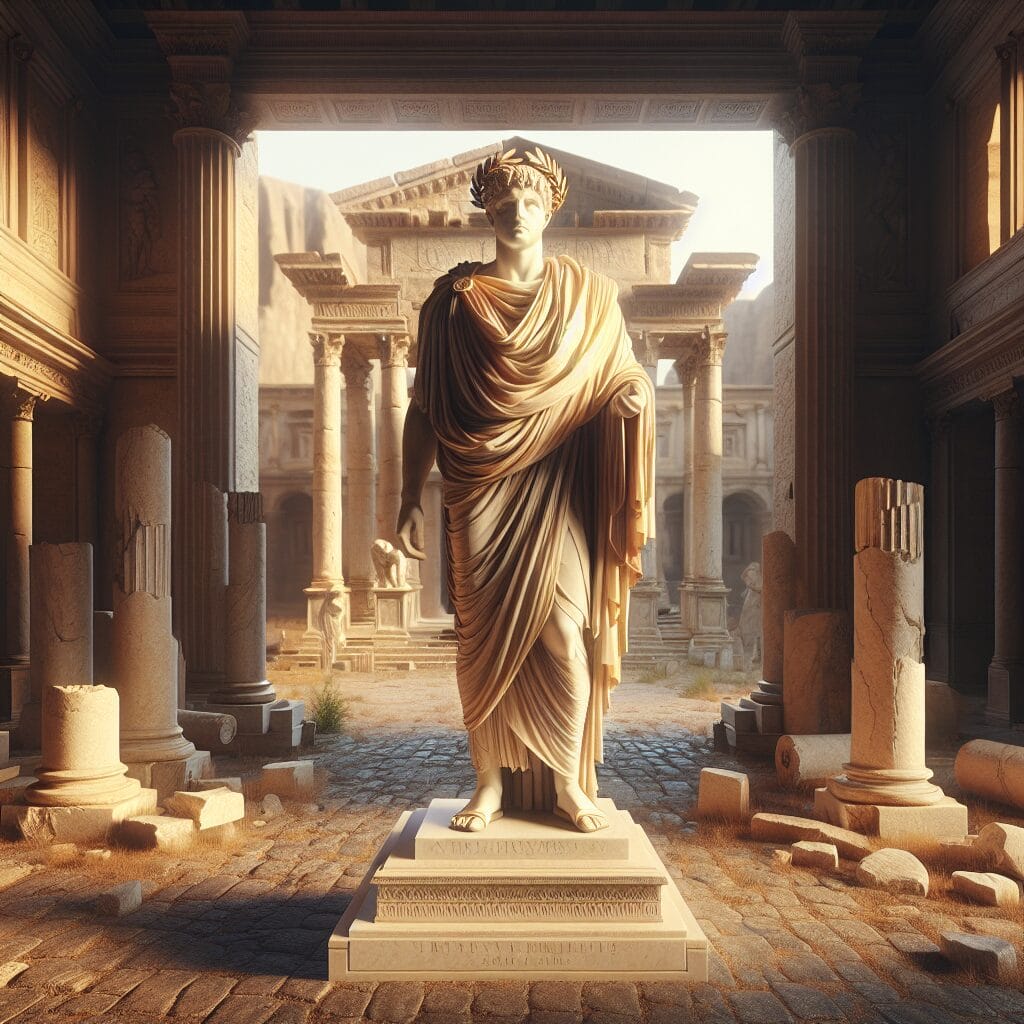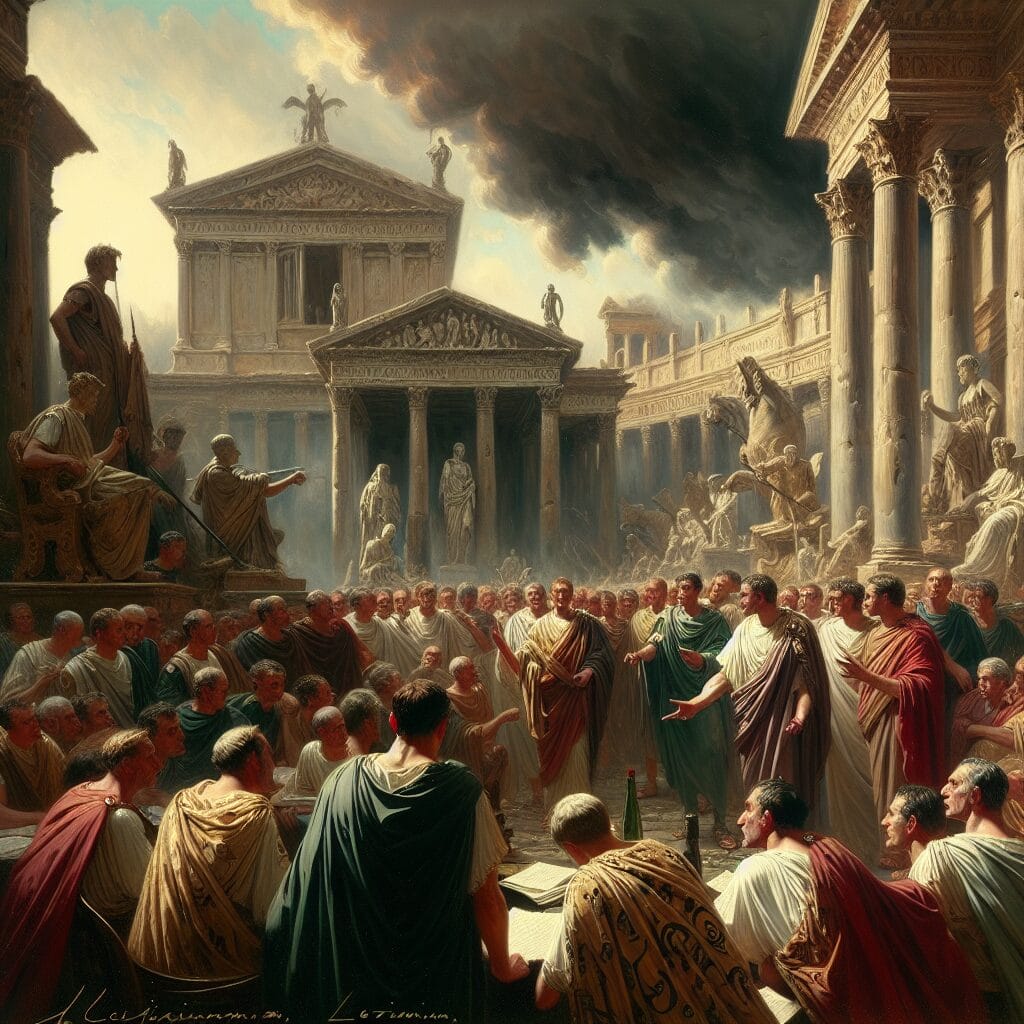The Roman military was a formidable force, renowned for its discipline and strategic prowess, which enabled Rome to expand its territories extensively. However, this dominance began to wane due to several critical factors.
Internal corruption, reliance on mercenaries, and poor leadership gradually eroded the army’s effectiveness. These issues, coupled with military defeats, exposed Rome’s vulnerabilities.
Understanding the decay of Rome’s military is crucial, as it played a significant role in the eventual downfall of the Western Roman Empire. This analysis sets the stage for examining these factors in detail.
Internal Corruption
Corruption among military leaders was a significant factor in the decline of the Roman army’s effectiveness. This pervasive issue was not confined to the military but mirrored the broader corruption in Roman governance. Military commanders often engaged in bribery and extortion, undermining the integrity of military operations. For instance, the systemic corruption in places like Leptis Magna saw military officials exploiting situations for personal gain, leaving the city vulnerable to barbarian threats.

The impact on discipline and morale was profound. The erosion of traditional Roman military training and discipline due to bureaucratic corruption weakened the legions’ cohesiveness. Soldiers, witnessing the corruption of their leaders, suffered from low morale, affecting their loyalty and commitment to the empire.

Numerous historical accounts, such as those by John Malalas and Libanius, highlight instances where soldiers extorted local traders, demanding goods at lower prices through intimidation. These practices not only strained civilian relations but also reflected a broader culture of entitlement and corruption within the ranks. The career of Flavius Abinnaeus further illustrates how bureaucratic corruption infiltrated military operations, creating administrative burdens and exploiting civilians.
Reliance on Mercenaries
The Roman army’s shift from citizen soldiers to mercenaries marked a profound transformation in its military structure. Initially, the army was composed of legionaries, recruited from Roman citizens, and auxiliaries from subject states. This composition ensured a cohesive force driven by loyalty to Rome. Over time, however, recruitment pressures led to a reliance on foreign troops, particularly Germans, reflecting a belief that effective soldiers were found outside urban centers.

This transition introduced significant challenges related to loyalty and effectiveness. Mercenaries, motivated primarily by financial gain, lacked the allegiance of native soldiers. Their commitment was often variable, contingent on pay and conditions, which posed risks during critical military operations. Cultural differences further complicated cohesion, undermining strategic effectiveness.
The economic burden of maintaining mercenaries was substantial. The financial strain of hiring these troops added to Rome’s economic woes, as the costs of recruitment and payment increased substantially. This reliance led to a less reliable and more expensive military force, complicating Rome’s ability to sustain its military operations.
| Aspect | Citizen Soldiers | Mercenaries |
|---|---|---|
| Loyalty | High | Variable |
| Motivation | Patriotism | Financial |
| Economic Cost | Lower | Higher |

Lack of Discipline
The erosion of traditional Roman military discipline played a critical role in the decline of Rome’s military prowess. Historically, the Roman army was renowned for its strict discipline, rigorous training, and cohesive structure. This discipline was a cornerstone of Roman military success, enabling effective command and control on the battlefield.

However, as the Roman Empire expanded and faced mounting external pressures, these standards began to deteriorate. The recruitment of foreign troops and mercenaries introduced variations in training and discipline. This shift resulted in a less organized and less effective fighting force, as these soldiers often lacked the same rigorous training as their predecessors.
“The decline in discipline eroded the effectiveness of the Roman army, leading to disastrous consequences in battle.” Without the steadfast discipline that once defined them, Roman forces struggled with maintaining formation and executing strategic maneuvers, ultimately compromising their battlefield performance.

Compared to earlier Roman military standards, the late Roman army was plagued by inconsistencies and a lack of cohesion. These deficiencies contributed to repeated failures in military campaigns, further exacerbating Rome’s vulnerabilities to external threats.
Poor Leadership
The decline of the Roman military was not solely due to external pressures and structural changes, but also significantly influenced by ineffective military leadership. Leaders who lacked strategic acumen and decisive action contributed to a series of military failures, which exacerbated the vulnerabilities of the Roman army.

A key instance of poor leadership was the disastrous defeat at the Battle of Adrianople in 378 CE. Emperor Valens, driven by hubris and a lack of coordination, engaged in battle without waiting for reinforcements. This decision led to a catastrophic loss against the Goths, showcasing how poor decision-making at the top echelons could lead to devastating outcomes.
The impact of such leadership failures extended beyond immediate military defeats. They eroded the confidence and morale of Roman troops, while also undermining the strategic integrity of Roman defenses. Leaders like Valens exemplified how inadequate strategic foresight and hasty decisions could cripple the empire’s military effectiveness.

In examining these leadership failures, it becomes evident that the absence of strong, competent leaders was a critical factor in the gradual decline of Rome’s military dominance.
Battle of Adrianople
The Battle of Adrianople, fought on August 9, 378 CE near present-day Edirne, Turkey, marked a pivotal moment in Roman history. Led by Emperor Valens, the Roman army faced a crushing defeat at the hands of the Germanic Visigoths under Fritigern, supported by the Ostrogoths. This battle highlighted the Roman Empire’s vulnerability to external threats and ignited significant Germanic incursions into Roman territories.

Key tactical errors contributed to this disaster. Valens underestimated the strength of the Gothic forces and engaged them without waiting for reinforcements, leading to a disorganized assault. The Romans’ failure to secure supply lines further weakened their position. Ultimately, the battle resulted in the destruction of Valens’s forces, with Roman casualties estimated to exceed 40,000. The loss of two-thirds of the Roman army shattered the myth of Roman invincibility.
The defeat at Adrianople severely tarnished the Roman military’s reputation, instilling fear and a sense of impending doom across the empire. It emboldened other barbarian tribes and marked a turning point, forcing a reevaluation of Roman military strategies and exposing the empire’s inability to protect its territories effectively.
Other Notable Defeats
Throughout its history, the Roman army suffered several significant defeats that cumulatively weakened its military prowess. These losses exposed vulnerabilities that eventually contributed to the decline of the Roman Empire.

- Battle of Teutoburg Forest (9 CE): This catastrophic defeat involved the annihilation of three Roman legions led by Publius Quinctilius Varus. Ambushed by Germanic tribes in the dense forests of present-day Germany, the Romans lost approximately 20,000 troops, marking a halt to Roman expansion into Germania.
- Battle of Adrianople (378 CE): As previously detailed, this conflict resulted in the death of Emperor Valens and the loss of over 40,000 Roman soldiers against the Visigoths. This battle severely damaged Roman military morale and highlighted the empire’s strategic weaknesses.
- Battle of Cannae (216 BCE): Although from an earlier period, this infamous defeat at the hands of Hannibal during the Second Punic War resulted in the loss of up to 70,000 Roman troops and became a historical reference point for future Roman military disasters.
These defeats not only resulted in substantial troop losses but also diminished the perceived invincibility of the Roman military. The cumulative impact of such losses eroded Rome’s ability to project power and maintain its territorial integrity, setting the stage for further challenges and invasions.
Barbarian Invasions
The decline of the Roman military was further exacerbated by the increased frequency of barbarian incursions across its borders. These invasions highlighted Rome’s growing inability to effectively defend its vast territories. The Battle of Adrianople in 378 CE, where the Roman army suffered a catastrophic defeat against the Visigoths, marked a pivotal moment in this trend.

Strategically, these incursions exposed the empire’s vulnerabilities, prompting barbarian groups to exploit Rome’s weakened defenses. The Goths, for example, successfully breached the Roman frontier following their victory at Adrianople, emboldened by the empire’s apparent fragility. Additionally, the influx of Hunnic pressure drove the Goths and other groups into Roman lands, further intensifying the invasions.
Significant invasions included the Visigothic sack of Rome in 410 CE and the Vandal conquest of North Africa in 429 CE. These events underscored the strategic failure of Roman defenses and led to the loss of key territories. Maps of these invasion routes reveal the complexity and scale of the challenges faced by the Roman military, illustrating the dire consequences of its diminishing capacity to secure the empire’s borders.
Attempts at Reforms
The Roman military, facing mounting external threats and internal instability, underwent several significant reforms aimed at revitalization. Early efforts were led by Gaius Marius in 107 BC, who transformed the army through the Marian reforms. These changes allowed the landless poor to enlist, increasing the recruitment pool and professionalizing the military. Marius’s introduction of tactics like the testudo and the triple line formation showcased the Roman military’s tactical ingenuity.

Later reforms in the late Roman Empire focused on restructuring the military into more agile units, such as comitatenses and limitanei, to better defend the empire’s extensive borders. There was also a strategic shift toward the integration of cavalry, recognizing the importance of mobility and speed in battle.
However, these reforms faced challenges. The Marian reforms inadvertently shifted soldiers’ loyalties from the state to individual generals, fostering political instability. Moreover, the Senate’s lack of support for veterans compounded these issues, leading to reliance on military power for political ends. Despite these reform efforts, the inability to effectively address internal corruption and ensure loyalty ultimately contributed to the Roman military’s decline.
Political Instability
The political chaos that permeated the Roman Empire was a significant factor in the decay of its military effectiveness. Corruption within the government drained essential resources, which undermined military funding and support, leading to operational deficiencies. Frequent changes in leadership further exacerbated these issues, as new emperors often prioritized personal agendas over cohesive military strategies. This instability disrupted military cohesion and resulted in inconsistent defense policies.

Moreover, the empire was plagued by endemic civil wars from the end of the second century AD, with only two decades free from conflict between 190 AD and 480 AD. These internal strifes not only diverted attention from external threats but also drained the empire’s resources and weakened its military strength. The military, originally designed to counter internal threats, was forced to abandon foreign campaigns to address these civil conflicts, further straining its capabilities.
The cumulative impact of these factors created a fragile military structure, incapable of defending the empire’s borders effectively. Historical examples, such as the sacking of Rome by the Goths in 410 AD, underscore the dire consequences of this political instability on the Roman military’s ability to maintain its dominance.
Economic Challenges
The Roman Empire faced significant economic challenges in maintaining its vast military forces, which placed a heavy financial strain on the state. As the size of the army expanded from approximately 250,000 troops under Augustus to over 600,000 by the reign of Diocletian, the cost of sustaining such a large force grew exponentially. This increasing demand for resources led to higher taxes and the debasement of the coinage, exacerbating the empire’s financial woes.

Inflation played a pivotal role in eroding the value of soldiers’ salaries. By 268 AD, the silver content of the denarius had plummeted to a mere 0.5%, resulting in rampant inflation with prices rising nearly 1,000%. Although emperors like Caracalla attempted to counteract these effects by increasing soldiers’ pay by 50%, the broader economic impact was detrimental. The general populace struggled to cope with rising costs and increased taxes, leading to social unrest and decreased morale.
Resource allocation further complicated military efficiency, but specific details on this aspect remain scarce. Nonetheless, the confluence of inflation, financial strain, and resource management issues contributed significantly to the decline of Rome’s military prowess.


